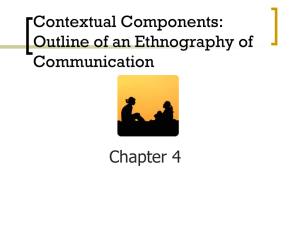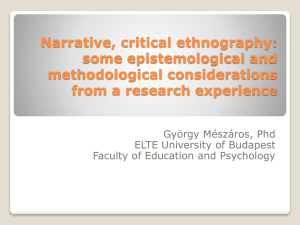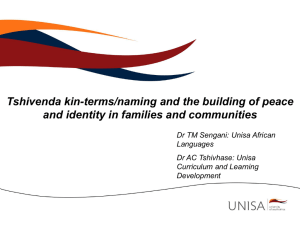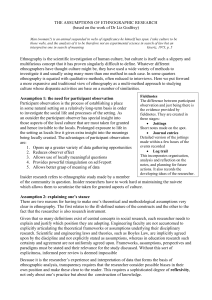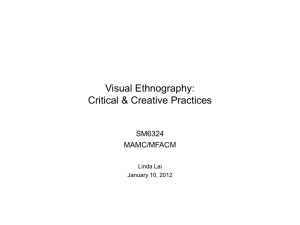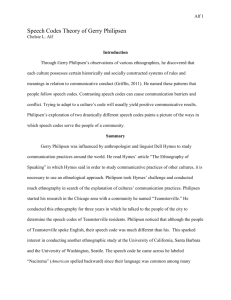Ethnography of Communication
advertisement
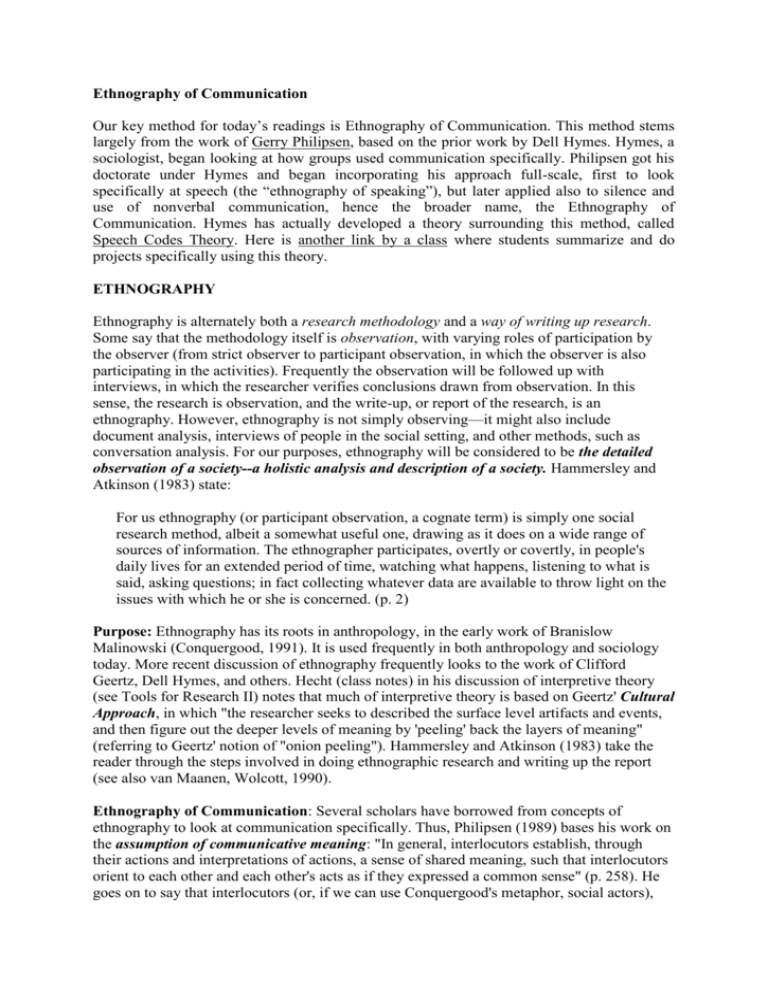
Ethnography of Communication Our key method for today’s readings is Ethnography of Communication. This method stems largely from the work of Gerry Philipsen, based on the prior work by Dell Hymes. Hymes, a sociologist, began looking at how groups used communication specifically. Philipsen got his doctorate under Hymes and began incorporating his approach full-scale, first to look specifically at speech (the “ethnography of speaking”), but later applied also to silence and use of nonverbal communication, hence the broader name, the Ethnography of Communication. Hymes has actually developed a theory surrounding this method, called Speech Codes Theory. Here is another link by a class where students summarize and do projects specifically using this theory. ETHNOGRAPHY Ethnography is alternately both a research methodology and a way of writing up research. Some say that the methodology itself is observation, with varying roles of participation by the observer (from strict observer to participant observation, in which the observer is also participating in the activities). Frequently the observation will be followed up with interviews, in which the researcher verifies conclusions drawn from observation. In this sense, the research is observation, and the write-up, or report of the research, is an ethnography. However, ethnography is not simply observing—it might also include document analysis, interviews of people in the social setting, and other methods, such as conversation analysis. For our purposes, ethnography will be considered to be the detailed observation of a society--a holistic analysis and description of a society. Hammersley and Atkinson (1983) state: For us ethnography (or participant observation, a cognate term) is simply one social research method, albeit a somewhat useful one, drawing as it does on a wide range of sources of information. The ethnographer participates, overtly or covertly, in people's daily lives for an extended period of time, watching what happens, listening to what is said, asking questions; in fact collecting whatever data are available to throw light on the issues with which he or she is concerned. (p. 2) Purpose: Ethnography has its roots in anthropology, in the early work of Branislow Malinowski (Conquergood, 1991). It is used frequently in both anthropology and sociology today. More recent discussion of ethnography frequently looks to the work of Clifford Geertz, Dell Hymes, and others. Hecht (class notes) in his discussion of interpretive theory (see Tools for Research II) notes that much of interpretive theory is based on Geertz' Cultural Approach, in which "the researcher seeks to described the surface level artifacts and events, and then figure out the deeper levels of meaning by 'peeling' back the layers of meaning" (referring to Geertz' notion of "onion peeling"). Hammersley and Atkinson (1983) take the reader through the steps involved in doing ethnographic research and writing up the report (see also van Maanen, Wolcott, 1990). Ethnography of Communication: Several scholars have borrowed from concepts of ethnography to look at communication specifically. Thus, Philipsen (1989) bases his work on the assumption of communicative meaning: "In general, interlocutors establish, through their actions and interpretations of actions, a sense of shared meaning, such that interlocutors orient to each other and each other's acts as if they expressed a common sense" (p. 258). He goes on to say that interlocutors (or, if we can use Conquergood's metaphor, social actors), coordinate their actions; communicative meanings are "created and the particular patterns of conduct that are enacted vary across communities" (p. 259). These communities of communicative resources are cultures. Thus, he defines culture as a "historically transmitted system of symbols, meanings, premises, routines, and rules" (p. 259). Philipsen’s Propositions of Speech Codes Theory (1989) Assumptions 1. Fundamental Axiom: 2. Coordinated Action: 3. Particularity in Meaning and Action: 4. Cultural Particularity For our purposes, we nearly need a summary of the theory as a whole—specifically that communicative action is specific to each group. That is, each group creates a set of resources for the people within that group for when, how, and to whom to communicate. People “coordinate” their meaning, but that meaning is specific to a culture. (Organizational researchers, such as Putnam, Pacanowski, and O’Donnell-Trujillo apply this principle even to the level of an organizational culture!) Many ethnographers of communication use Dell Hymes' descriptive framework to research and present their findings. This framework (Hymes, 1972), is intended to be used to look at any naturally occurring speech to discover the rules for speaking (modes of speaking, topics, message forms within particular settings and activities). The key elements [SPEAKING] are: Scene: physical setting where talk occurs, cultural definition of the scene Participants: the actors in the scene and their role relationships Ends: the purpose(s), outcomes, goals of talk Act Sequence: the relationship between what is said and how it is said Key: the tone, manner, or spirit in which the talk [or silence] occurs Instrumentalities: particular channel, language, dialect speech variety of the talk Norms: normative aspect of interaction; normative aspect of the interpretation of talk Genre: the cultural category of talk (e.g., insults, compliments, apologies) Examples of Ethnography of Communication Typically, a single study will not walk through each of these, but will use the ones that are most relevant. For example, if we wanted to look at shaking hands, we could start at the “genre”—shaking hands as a sign of showing friendship (e.g., flipping someone off might be an insult or a gesture of camaraderie). We could then find out who shakes hands in a culture (participants), the scene (only upon first meeting, or do you always shake people’s hands when you see them again. Hmmm. ‘Hi Mom! Glad to be home (hand shake).” “Hey, dude, whassup” (handshake). . . No, I don’t think so. We could determine why people shake hands, the “key” or tone (for example, in the flipping off example, one might flip a stranger (participant) off in traffic or at a grocery story (scene), following either a traffic goof-up or someone saying something rude to begin with (act sequence). Here the key would be tense, uncomfortable, angry. But if you are at a game and your buddy flips you off, the tone could be “joking,” “light,” etc. The instrumentalities are the channel. Thus, if we take a larger “genre” of camaraderie behaviors, these could be verbal or nonverbal. The norms dictate the expected rules for how to shake hands (not a wimpy shake, not too firm, not too long, and don’t milk the other person’s fingers!). Carbaugh (1994) goes on to list three areas of interest to the student of cultural communication: 1. Cultural Models of Personhood: What does it mean to be a (good) Osage Indian, a good Anglo American, a good ISU Greek member? 2. Communication: How is communication accomplished? What are the logic patterns, forms of talk (e.g., metaphor, word usages, analogies, argument styles), meanings, and rules. 3. Emotional Expression: As an example of the above, what are the "display rules" of when and how emotion should be displayed. Note that these three intersect with one another. That is, emotional expression has certain meanings. In some cultures, to be a "real man" means not showing certain emotions, or to be a real "x" might mean showing emotions in certain ways. It is within this framework that our readings for today fit. The two readings from the MN&F reader are both from students who got their doctorates under Dr. Philipsen and are now professors at different universities. II. Specific Studies on Culture and Identity: A. American Indian Students (Carbaugh) Carbaugh, D. (2002). “I can’t do that!” but I “can actually see around corners: American Indian students and the study of public “communication.” In In J. N. Martin, T. K. Nakayama, & L. A. Flores (Eds.), Readings in cultural contexts (2nd ed., pp. 138-149). Mountain View, CA: Mayfield. Thought Questions: - According to Carbaugh, what is the role of Blackfoot “deeply communicative silence”? What seem to be the main values that undergird Blackfoot communication? - What constitutes “effective communication” for Blackfoot culture? - What is nixokowa and what does it express (p. 141)? - What are the premises (underlying assumptions) of the “Whiteman’s” culture? - How might this impact the Blackfoot student in the mainstream classroom? - What, according to Carbaugh, should be the researchers role as it regards learning and writing about other cultures? - Photo credits: http://www.glenbow.org/blackfoot/teacher_toolkit/french/culture/takingCont rol_Print.htm - http://rolsi.uiowa.edu/editorialboard/carbaugh_d.html B. Leave-Taking in Colombia (Fitch) Fitch, K. L.. (2002). A ritual for leave-taking in Colombia. In In J. N. Martin, T. K. Nakayama, & L. A. Flores (Eds.), Readings in cultural contexts (2nd ed., pp. 149-155). Mountain View, CA: Mayfield. Thought Questions: - Describe what Fitch calls the salsipuede ritual (Note: This is her own name for the ritual, though it makes sense). What is the “act sequence” involved (to use - Notice the transcript notation in Fitch (e.g., pp. 150-151). This is quite different from the way Carbaugh uses transcripts (and different from anything you will do in COM 372!). She is using a sort of conversational analysis, which uses a much more fine-tuned look at stops, starts, interruptions, and so on. - What are the underlying values that the salsipuede ritual represents? Fitch, along with most ethnographers of communication, would argue that communication rituals such as this reflect the underlying psychology (meanings, values) and sociology (social structures) of a culture. We could see the same returning to our handshake structure or to bows in some Asian cultures. How starts the bow or the handshake? How long does one hold it? Who is allows to interrupt and in what way? We could easily apply the speaking framework to a ritual of any culture at any level to uncover the underlying structures and meanings of the culture. - A family example: In the Baldwin family, there is what I call the “Dinner Dictionary Ritual.” In this ritual, the family is discussing some idea (postmodernism, euthanasia, narcissistic, etc.) and a term comes up. Sometimes it is regarding the origin of some term (on which Nordic god does the English word “Tuesday” come from, and how does this relate to the Spanish martes, which is based on Mars, the god of war?), sometimes on the pronunciation of a word, and sometimes on a concept. We used to run downstairs to get a dictionary, but finally just gave up and moved the dictionary to a bookshelf that sits close to the kitchen table. Genre: Seeking information in the dictionary (I often find it easiest to start here!). Participants: The Baldwin family—mom, dad, 11-year old daughter, and 15-year old son (as of June 4, 2007!). Any one can get the dictionary, but so far, it tends to be the three oldest members of the family. Act sequence (and I’ve deliberately taken this out of order so that we do not seek SPEAKING ritual as a lock-step process): There is some lively discussion, over some term, concept, or current event (requiring knowledge of some place). This gives rise to different opinions. Sometimes simply to clarify or seek information, and sometimes to prove him or herself right (ends), someone goes and gets the dictionary— sometimes an atlas, which lives right next door to the dictionary. The person looks up the word or place, brings the information to the table, and we continue chatting about the topic while we eat. The key is usually friendly, sometimes competitive, and the instrumentality—here less important, is the use of a standard reference source to provide “verifiable facts” to answer some question that has come up. Often looking up in the dictionary ends a particular dispute, as if the dictionary has authority, though sometimes someone chooses to disagree with it or extend its finding—or comment that we need a more up-to-date dictionary. However, notably, we never do this if there is an actual argument with a negative key, if relationships or emotions are on the table, and we never do it spitefully, reflecting the norms of the hunt. Undoubtedly, this ritual reflects some underlying values specific to the Baldwin family culture, as well as power structures (in that anyone call for or get the dictionary but not everyone does), though perhaps dominant in larger cultures (you can decide what those are.). Visitors to the Baldwin table are free to engage in the ritual, though they rarely seek the dictionary and some protest the ritual: “Hey, we’re not in school!” Thought Box: Describe a cultural communication ritual using Hyme’s SPEAKING framework (or as much of the framework is applicable—but try to use at least 4 of the aspects). This can be a ritual of a culture (with a small c) to which you belong—workplace, organizational, household. Or it can be a larger cultural ritual that you have observed. Try to use one that you have observed frequently, so that you do not draw a strong conclusion about a culture based on insufficient evidence. Finally, tell what the ritual might reveal about the underlying psychology (values, beliefs), sociology (social structure, relations) or rhetoric (ideology, underlying assumptions) of the culture. Sample Ethnographies: Rhetoric in flames (“fire inscriptions” among Israeli youth): https://www.mlb.ilstu.edu/ereserve2/viewpdf.php?filename=JBCOMKAT.PDF Sites of memory: Israeli historic museums and the way the guide handles the “artifacts” depending on whether the museum visitors are Jewish or Palestinian: https://www.mlb.ilstu.edu/ereserve2/viewpdf.php?filename=JBCOMKA2.PDF Doing Whiteness in the College Classroom (ethnography of a college “performance” classroom on intolerance) https://www.mlb.ilstu.edu/ereserve2/viewpdf.php?filename=JBCOMWAR2.PDF Latino Nights: a study of a nightclub that has a special night for “Latinos” in Ohio: http://firstsearch.oclc.org.proxy.lib.ilstu.edu:2048/html/webscript.html:%3Asessionid=fsapp1032951-exqietn9-6zp6o5:sessionid=fsapp10-32951-exqietn9-6zp6o5: Directive sequences in Colombia & Colorado (using ethnography & interviews): https://www.mlb.ilstu.edu/ereserve2/viewpdf.php?filename=JBCOMFI2.PDF Talking “race” in the classroom (not on-line, but Baldwin has a copy) Optional readings for your files! More on the background of ethnography—another reading for your files on Speech Codes Theory by Philipsen: https://www.mlb.ilstu.edu/ereserve2/viewpdf.php?filename=JBCOMPH2.PDF Clearly beyond the scope of our class—but a good “qual methods” reading: Rethinking how we do ethnography in a “postmodern”/ “critical” sense: https://www.mlb.ilstu.edu/ereserve2/viewpdf.php?filename=JBCOMCO2.PDF Note: See Philipsen & Carbaugh (1986) for a bibliography of fieldwork on ethnography of communication; Leeds-Hurwitz (1990 for a review of three works, including Katriel's talking straight. Braithwaite and Carbaugh have also prepared a paper on the contribution of ethnography of communication to the study of intercultural communication. C. Language and Cultural Identity (either Jandt, 2004, Ch. 17, or Jandt, 2007, Ch. 15) We are taking this chapter quite out of order as it relates to the use of language to reflect cocultural identity, thus joining two concepts we studied last week. Much of the chapter will not require much of our attention at this time, and I am not providing a detailed look. What is most interesting for our purposes here is the extended example at the end of the chapter, where Jandt focuses on several aspects of language (and media) use by gay and lesbian cocultures. He does use several other interesting case studies, but we will be focused more on the main terms and ideas than on these cultures. o What is argot? What are its functions? What does it have to do with group identity? o Note several examples of argot: Working class British punk Corporate culture Thought Box: Give an example of argot used by a group to which you belong. Discuss how it meets the different functions of argot. o Case study: Gay, Lesbian, and Transgendered Communities How do labels work both against and for a group? What are some different positions a group can take towards the use of labels (e.g., reclaiming, rejecting)? does it mean for a group to reclaim a label? What are some specific labels relative to GBLT groups, and what are the implications of those labels? Why do some people reject labels? [P.S. Beyond our discussion, but interesting thought—how would this relate to either the communication theory of identity or to co-cultural theory!?] How do media work both against and for a group? (Much of Jandt’s coverage is on GBLT media, magazines, and so on. However, some scholars also look at some of this same media, such as Will and Grace or Queer Eye for a Straight Guy and show how, while it brings gays or lesbians visibility, it also continues to stereotype them or show limited ranges of their occupations, characteristics, and so on. It is interesting to see how many advertisers today are making gay-friendly images or images that are, at a minimum, ambiguous (uncertain) in how they can be read. Homophobia versus heterosexism: What is homophobia and what are some of the causes of it? Important Note: Here is a note from our prejudice page that also applies here: For example, Thomas Nakayama (an editor in one of our texts and researcher of critical rhetoric and gay and lesbian studies) wrote in 1998 that the notion of homophobia—an irrational fear of people who are gay or lesbian or of gay or lesbian behavior— is not really a totally useful term, as it points only to individuals who are irrational. As long as people can defend the rationality of their beliefs, they can avoid the charge. He opts, instead, for heteronormativity (or heterosexism). While heterosexism refers to the privileging of heterosexual identity, heteronormativity points out the societal structures in place that maintain the centrality of heterosexuality. It treats anti-gay sentiment at the societal, rather than the individual level. To this end, much of what Jandt discusses here, discrimination and laws against transgendered people (as well as talk, media, and so on that simply assume heterosexuality) should really be dealt with more as heterosexism. Homophobia, thus, is merely a personal psychological fear of same-sex sexual orientation or individuals so oriented. Some final points: We should not speak of gay/lesbian as sexual preference, but as sexual orientation. Even groups such as Exodus International, which hold that one can adjust one’s sexual orientation, do not believe that individuals simply wake up one day and decide they will be gay or lesbian. The distinction between homophobia and heterosexism is an important one! If one focuses only on the homophobia, she or he will only worry about individual-level psychology. If I, personally, do not feel dislike towards lesbians or gays, then I am absolved from social responsibility. If one holds that prejudice towards lesbians and gays is societal—in laws, policies, and so on—then one will be compelled to seek societal solutions, rather than simply individual absolution, for the intolerance. Just as with African American or Latino identities, there are really multiple constructions of gay or lesbian identity, based on communication within groups. In addition, many people oppose these categories, arguing that the line between gay and straight is socially constructed (what it means to be “gay” in Brazil is different in the United States!), and fluid (many might have same sex sexual thoughts or fantasies or even interactions—at what point one becomes “gay” is largely a social construction). For an interesting final thought, take this on-line quiz!: http://orgs.tntech.edu/lambda/survey.html Thought Box: Sexual identity: Take the Heterosexual Survey: http://orgs.tntech.edu/lambda/survey.html. Give your own thoughts about what you think the survey is saying or about your own score on the survey. OR Think about the politics of labeling: Who should be able to use language, such as the N-word to describe African Americans or the “Q” word to define gays or lesbians? Is in-group and out-group usage of the language the same in intent and/or harm? Justify your answer. Dialogue with others, as long as you do it in respect!

